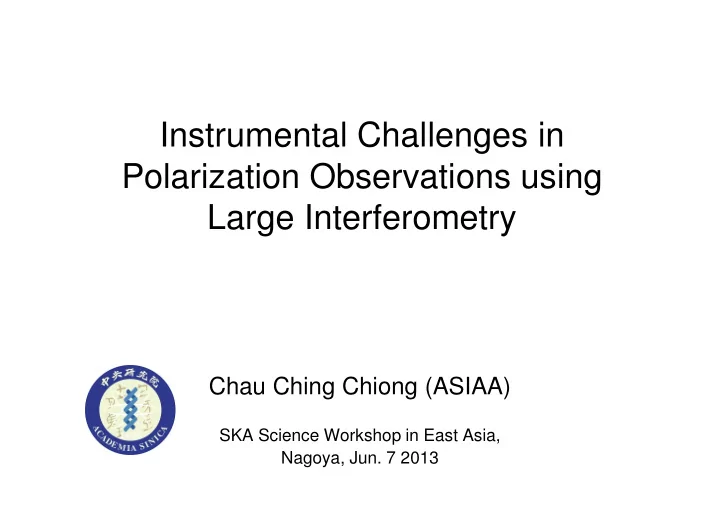

Instrumental Challenges in Polarization Observations using Large Interferometry Chau Ching Chiong (ASIAA) SKA Science Workshop in East Asia, Nagoya, Jun. 7 2013
Outline • Polarization observation overview • Source of polarization leakage • ALMA Band-1 front-end system • Current receiver performance • Current receiver performance • Ways for improvement • Summary
Polarization Observation Probing Magnetic Field: • Synchrotron radiation • Faraday rotatoin Girart+ (2006) • Goldreich-Kylafis effect < 5% • Goldreich-Kylafis effect < 5% • AGN polarization: 5-10% • Dust polarization: 1% • Zeeman effect: 0.1% • CMB polarization Crutcher+ (1999)
Polarization Leakage in Interferometry • For linear feed like ALMA. X/Y-signal leakage to Y/X- feed. • Stokes I signal goes into Q, U, and V, and generates “instrumental polarization”. • Neglecting higher order terms (small leakage), • Neglecting higher order terms (small leakage), Parallactic angle G and D need to be determined
Characterization of Instrumental Effects • Time-invariant – Antenna Feedhorn – Optics – Feedhorn – Feedhorn OMT – Orthomode Transducer RF LNA • Time-variant LO LO mixer – Front-end (amplifier, mixer) gain IF LNA – Back-end To back-end (correlator etc.)
ALMA Band-1 Project Overview • Led by ALMA-EA (ASIAA) • Cooperation with HIA (Canada), NRAO (USA) and U Chile. • Freq.: 35-52 GHz in SSB operation • Receiver Noise Temp.: 25-32 K (expected) @ 15K • PDR in July 2013 • CDR in 2014 • End of project: Summer 2019
ALMA Band-1 Polarimetry • Unique science: Zeeman Measurement via circular polarization (Stokes V) • CCS(4 3 -3 2 ) f= 45.379033 GHz • Dense core • Detect 1mG in hours 1 hr integration 10 hr integration
Summary of Instrumental Leakage • Antenna: geometry is given: beam squint is proportional to the offset distance • Optics + Feedhorn < -40 dB (1%) (band center); < -30 dB (3%) (band edge) • OMT < -40 dB (< 1%) • OMT < -40 dB (< 1%) • Amplifier gain: < 0.1% (spec.) but sensitive to ambient temperature drifting. • Antenna deformation is not obvious. • Maximum deviation in D-term (ALMA spec.): -12 dB (6%)
Typical Calibration Strategies • Determine the Jones/Mueller matrix. • Calibration source is slightly linear polarized. • Using long observation on calibration source with different parallactic angle. Source polarization is rotating with the sky but instrumental polarization is fixed. – Time consuming. • After calibration, error is of order of 0.1% of Stokes I. • After calibration, error is of order of 0.1% of Stokes I. From Johnston 2002
Current VLA and ALMA Receiver Performance VLA: • D ~ 1% at low frequency (C-, X-band), 5-6% at high frequency (K-, Q-band) • Not time-stable. ALMA: ALMA: • Nagai et al. (2012) measured the polarization performance of current ALMA Band-3, 6 and 7. • D-term in Band-3 < 3%, Band-6 < 5%. • Each antenna has its own feature. • Off- beam axis degradation. Best at phase center. • Time variation of 10% over two days, mostly from front- end electronics(?).
D-Term Time Variation in ALMA Different Date Frequent calibration required From Nagai+ 2012
Ways for Improvement (1) • In ALMA, time-variant error causes problem in high sensitivity polarization measurements. • Adding correlated noise source. • Adding half/quarter-wave plate to provide higher flexibility in provide higher flexibility in calibration. – Half-wave plate exchanges the polarization state of two linear polarization. – Quarter-wave plate changes linear into circular feed (or vice versa).
Ways for Improvement (2) • For ALMA Band-1 or future SKA, stable and powerful calibration source with high signal-to-noise ratio and changeable polarization feature is possible. • Photonic phase calibrator: one of the ALMA-EA development item led by Dr. Hitoshi Kiuchi (NAOJ). From Kiuchi
Summary • The origins of the polarization leakage are identified. • D-term is in a few %, with off-beam center degradation. degradation. • There are two component corrupting the polarization: time-invariant and time-variant. • Time-invariant should be antenna based. • Time-variant needs more investigations. • Applying experience from ALMA to SKA.
Recommend
More recommend